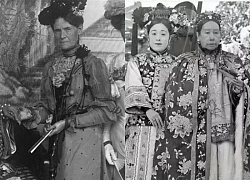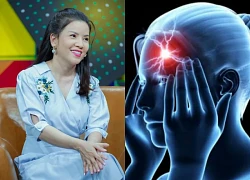Lee Seung Gi shocked when he confessed to having psychological treatment, pretending to be fine for fear of fans knowing

4 | 0 Discuss | Share
Lewis Caroll's famous novel "Alice in Wonderland" is one of the most successful children's works of all time. Few people know, in real life this is a dangerous psychological syndrome.
Alice in Wonderland is a children's story written by British mathematician Charles Lutwidge Dodgson. The story follows the adventures of little Alice, after accidentally falling into a rabbit hole, into a strange world, where everything is either too small or far beyond her stature.
However, behind Alice's shadow there is also a scary event that is also "commemorated" that few people know: the "Alice in Wonderland" syndrome.
From real patients documented in history...
People with Alice in Wonderland syndrome (AWS) perceive themselves as bigger or smaller than they actually are. They may also see how the room they are in — or the surrounding furniture — seems to be shifting, far away — that isn't close to reality.
This phenomenon is not caused by eye problems or hallucinations. The cause is changes in the way the brain perceives the surrounding space and the body.
This syndrome can affect many senses, including sight, touch, and hearing. Sufferers are also prone to lose their sense of time, which passes faster or slower.
AWS primarily affects children and young adults.
According to experts, this is one of the very rare syndromes, but it can cause many consequences and seriously affect human life and health. Patients will face both physical and mental symptoms, often feel headaches, loss of awareness, distortion of time, sound, loss of control of limbs,...
AIWS patients have certain distortions in the perception of the size of things and will have symptoms such as micropsia and macropsia. That is, sometimes they see external objects or body parts of themselves more than usual. Smaller or larger in size, which is also the most common symptom of Alice in Wonderland syndrome.
In addition, the patient's perception of distance will also be skewed and there will be teleopsia and pelopsia phenomena. For example, a corridor may appear long or the ground may appear too close. Sometimes they may encounter the phenomenon of "image crumbling".
However, a recent patient case shows that the occurrence of AIWS is somewhat more complicated. This syndrome is named by British psychiatrist John Todd after Lewis Carroll's children's adventure novel (published in 1865).
The patient in the study — a 26-year-old man — came to psychiatrists with a history of using alcohol, banned substances and LSD (lysergic acid diethylamide, a hallucinogen). With LSD stimulation, patients often see objects of peculiar size — namely, things that are suddenly too big, too small, too far away, or too close to reality.
That suggests the patient experienced some of the same symptoms as the little girl in Lewis Carroll's novel "Alice in Wonderland." But what is different about this case is that the patient no longer uses LSD when experiencing such hallucinogenic symptoms. In other words, after being "killed" with all banned substances, the symptoms of AIWS continue to occur!
Another case published by the medical journal Neurocase is that of a 55-year-old man from Italy. One day when he was using the computer, he suddenly saw icons jumping off the screen and hovering in front of his eyes. For about 10 minutes, the symbols danced back and forth before his eyes before drifting to the right and disappearing.
He was diagnosed with Alice in Wonderland syndrome. More frighteningly, the cause of this odd syndrome is a high-grade glioblastoma tumor — a form of brain cancer that progresses rapidly and causes loss of life.
Before the onset of AIWS symptoms, patients frequently experience severe headaches, nausea, and sensitivity to light. The test results also showed that the tumor had compressed nerves in the eye area, affecting vision. It is known that this is the first recorded case of Alice syndrome in Wonderland caused by brain cancer. This syndrome is most often triggered by epilepsy, drug intoxication, migraine, mental illness.
According to Aurora, AIWS is caused by brain oversensitivity. Hypersensitivity begins to occur in the occipital lobe, the visual area located at the back of the brain. However, it can spread to the parietal lobe located just before the occipital lobe. Aurora explains: "The parietal lobe region distinguishes sizes and shapes." Arturo Lerner and his colleagues suggest that LSD may have temporary adverse effects on the lateral geniculate nucleus, the brain region involved in visual perception. Temporary weakening of this area of the brain causes symptoms: seeing things that are too big (macropsia), too small (micropsia), too close (pelopsia) or too far away (teleopsia).
A spokesperson for AIWS Info said: "There is currently no effective treatment for AIWS. And the syndrome sometimes becomes unbearable for patients." There is no record of writer Lewis Carroll using psychiatric drugs. However, Carroll recorded in his diary the condition of his pain, which led to the suspicion that this headache was the starting point of the novel Alice in Wonderland. But according to Aurora's research, AIWS tends to disappear as patients age just like the character Alice in Carroll's novels.
Strangely, the girl with the syndrome sleeps 22 hours a day, can sleep 4 days in a row without eating  T.P14:03:31 15/03/2023The online community had the opportunity to stir up before the story of a girl with a strange syndrome in the world, sleeping up to 22 hours a day, without eating and still not feeling hungry, just sleeping. In the past few days, on social networks, netizens are constantly...
T.P14:03:31 15/03/2023The online community had the opportunity to stir up before the story of a girl with a strange syndrome in the world, sleeping up to 22 hours a day, without eating and still not feeling hungry, just sleeping. In the past few days, on social networks, netizens are constantly...

4 | 0 Discuss | Share

1 | 0 Discuss | Share

5 | 0 Discuss | Share

3 | 0 Discuss | Share



1 | 1 Discuss | Report